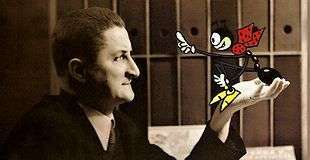Ondřej SEKORA, popular writer, journalist, illustrator, amateur entomologist and founder of Czech rugby, author of the legendary all-rounder Ferdy Ant and other popular characters, was born 125 years ago. In addition to newspapers, he has also worked with radio, television, film and theatre.
He was born on 25 September 1899 in Králová Pole, which is now part of Brno, as the third of six children of Ondřej Sekora, a teacher. When he was seven, his father died and his mother Anna had to take care of the children. She did not really have money to spend, but she tried to give all her children the best education. Ondřej graduated from the general school in Královův Pol, then headed to the grammar school in Brno, after moving to Vyškov in 1913. He collected butterflies and beetles, played sports, read a lot and liked to draw. At the end of the First World War he was conscripted as a one-year volunteer into the army, fortunately not in the trenches, but in Vienna, where he liked to visit galleries and museums during his leave. He did not graduate until after the war and, at his mother's request, went to law school, but soon discovered that this field was far from his grasp. He became fascinated with journalism.
In 1921 he left his studies and joined the Lidové noviny in Brno as a sports editor and cartoonist. At that time, no section could do without a cartoonist, as the quality of the press made it almost impossible to publish photographs.
The year 1923 was an important one in his life: in the spring he married Markéta Kalabusová and in September they went to Paris together, where he was sent by Lidové noviny. As a journalist, he took part in the Winter Olympics in Chamonix and some of his reports with pictures were printed in French newspapers. After a year he divorced and in 1927 he completed a second Paris internship. He was a reporter for the Tour de France, wrote feuilletons and barrels, and drew cartoons as well as illustrations.
In France, he became passionate about rugby and helped to promote it when he returned home. He translated and drew the rules of the game, invented the Czech rugby terminology, became a coach of the first clubs and by 1944 was also a referee, refereeing the first rugby match in our country.
In 1928, Sekora joined the Prague editorial staff of Lidové noviny, where he was assigned the children's section Dětský koutek (Children's Corner). At that time, he was privately studying drawing and painting with Professor A. Hofbauer at the School of Applied Arts, where he developed his own style, which was far from animation. In his picture series, the forerunner of today's comic strips, which appeared in the Sunday supplement of Lidové noviny, he brought children stories full of suspense, humour and situational comedy. Probably the most popular was Napipi the chicken and then, of course, Ferd the Ant, who made him famous.
He drew the first comic book character Ferdy Ant in 1927, back then with stories for adults - the restless ant got drunk on nectar from flowers and harassed Ladybugs. A hard-working and imaginative guy who knows how to do everything, he was created in January 1933. The Baggins Beetle followed him in 1935. In 1936, a children's book was published with these characters Ferd the Ant and aroused such interest that Sekora published two more books immediately afterwards, Ferda Ant in the service of others a Ferda in the anthill and over time, he added more. After the war, from 1950 onwards, the series Mateřídouška was published in Pieces of Ferdy Ant's youth. Everything Sekora wrote he verified, which is why his books were read with interest even by natural scientists. He made up his stories, but everything in them was true about nature.
In 1941 he had to leave the editorial office of Lidové noviny because his second wife, Ludmila Roubíčková, whom he married in 1930, was Jewish and he refused to divorce her. He was expelled from the National Union of Journalists and from 1944 until the end of the war he was interned in labour camps in Poland and Germany. There he kept a diary and with his fellow prisoner, the actor Oldřich Nový, performed a puppet show. His wife ended up in Terezín, and although she contracted typhus, she survived the war and they were happily reunited with their son Ondrej, who was born in 1931 and was cared for by relatives in Jevíček.
In the post-war years Sekora joined the Communist Party of Czechoslovakia, became editor of the daily newspaper Práce and the magazine Dikobraz, and in 1949 co-founded the State Publishing House of Children's Books, today's Albatros. He was behind the first attempts at television broadcasting for children, played puppet theatre and organised talks with children all over the country. From 1952 he was a freelance writer, writing and drawing for Lidové noviny, Hosta do domu, Mateřídouška, Ohníček, Pionýr. During his lifetime he illustrated 40 books by other authors and published twenty-five of his own.
In 1964, he was named a Meritorious Artist and in 1966 he received the Marie Majerová Prize for Literature.
A stroke in 1964 ended his public activity. He died in Prague on July 4, 1967 and is buried in Košíří at the Na Malvazinkách cemetery.
Gnews.cz - Jana Černá
Photo - Moravian Museum Brno



